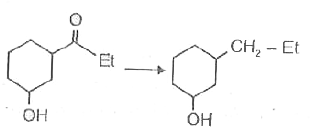Acetamide is treated separately with the following reagents. Which one of these would give methyl amine ?
NaOH/Br2
Sodalime
Hot conc. H2SO4
PCl5
The correct Answer is:A
To determine which reagent will convert acetamide to methyl amine, we can follow these steps:
1. Identify the Structure of Acetamide:
Acetamide has the chemical structure CH₃C(=O)NH₂. It consists of a carbonyl group (C=O) attached to an amine group (NH₂).
2. Understand the Reaction Type:
The reaction we are interested in is known as the Hofmann degradation reaction. This reaction involves the conversion of an amide to a primary amine with the loss of one carbon atom.
3. Identify the Reagents:
The reagents typically used in the Hofmann degradation reaction are sodium hydroxide (NaOH) and bromine (Br₂).
4. Write the Reaction:
When acetamide reacts with NaOH and Br₂, the carbonyl carbon is eliminated, leading to the formation of methyl amine (CH₃NH₂) and sodium bromide (NaBr) as a byproduct.
The reaction can be summarized as:
CH3C(=O)NH2+NaOH+Br2→CH3NH2+NaBr+H2O
5. Conclusion:
Therefore, the reagent that will give methyl amine when acetamide is treated is NaOH and Br₂.
Final Answer:
The correct reagent that will convert acetamide to methyl amine is NaOH and Br₂ (Option A).
Acetamide has the chemical structure CH₃C(=O)NH₂. It consists of a carbonyl group (C=O) attached to an amine group (NH₂).
The reaction we are interested in is known as the Hofmann degradation reaction. This reaction involves the conversion of an amide to a primary amine with the loss of one carbon atom.
The reagents typically used in the Hofmann degradation reaction are sodium hydroxide (NaOH) and bromine (Br₂).
When acetamide reacts with NaOH and Br₂, the carbonyl carbon is eliminated, leading to the formation of methyl amine (CH₃NH₂) and sodium bromide (NaBr) as a byproduct.
CH3C(=O)NH2+NaOH+Br2→CH3NH2+NaBr+H2O
Therefore, the reagent that will give methyl amine when acetamide is treated is NaOH and Br₂.
The correct reagent that will convert acetamide to methyl amine is NaOH and Br₂ (Option A).
Similar Questions
Knowledge Check
Which of the following can give 1° amine?
APh−CH3∣CH−OHNaCN,H⊕−−−−−−→BPh−CH=CH−O∣∣C−NH2NaOCI−−−−−−→CH3OHCPh−C≡C−O∣∣C−NH2NaOBr−−−→DPh−O∣∣C−CINaN3−−−−−→Δ,LiAIH4−−−−→Which of the following reactions would give the best yield of t-butyl methyl ether?
A(CH3)3C−OHH2SO4−−−→140∘CB(CH3)3C−Br+CH3OH→C(CH3)3C−Br+CH3өONa⊕→D(CH3)3C−өO⊕K+CH3Br→
Which of the following reduction reactions does not give an amine as product?
View SolutionA solution of KBr is treated with each of the following which one would liberate bromine?
View SolutionWhich one of the following reagents is not suitable for the elimination reaction?

View SolutionGive balanced equations for the following reactions :
How will you convert ethyl amine to methyl amine?
View SolutionWhich of the following reagent can be used to separate AgCl and AgI?
View SolutionReduction of nitrobenzene by which of the following reagent gives aniline?
View Solution

